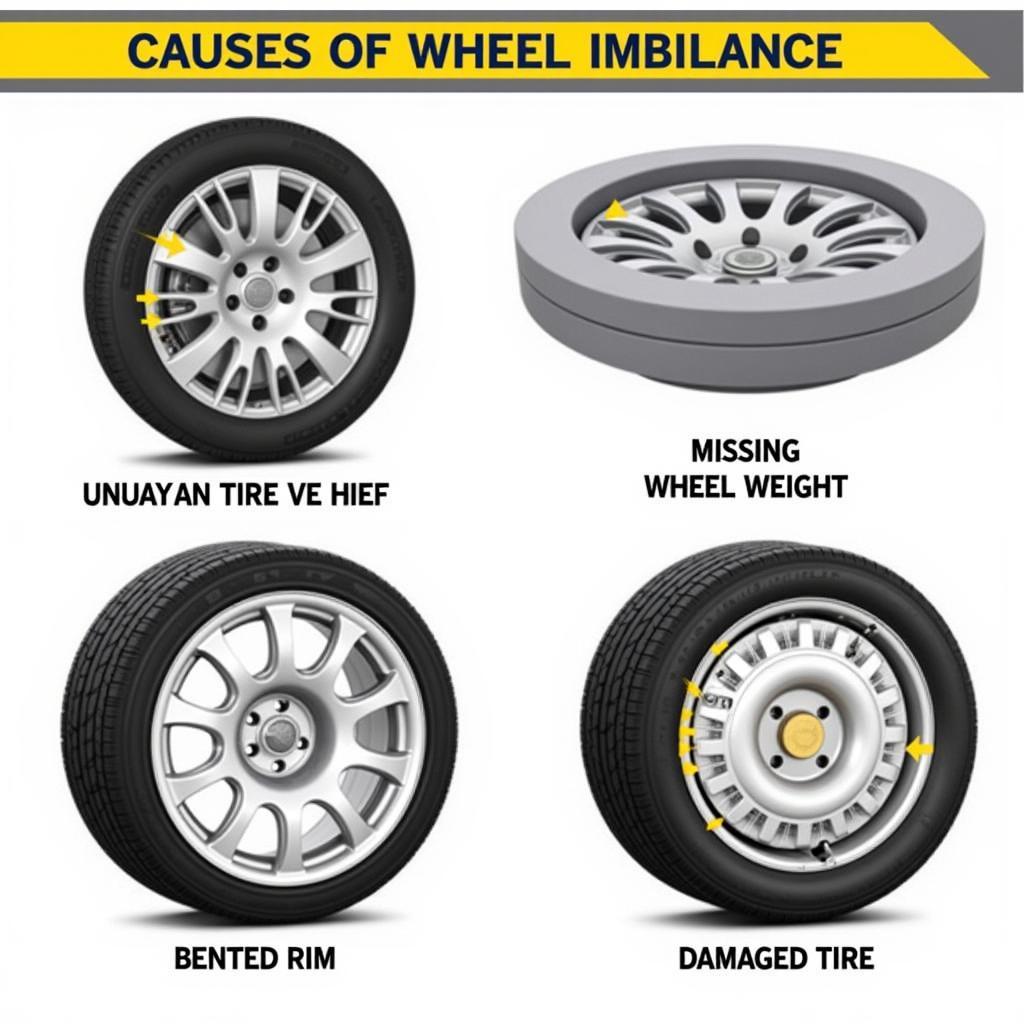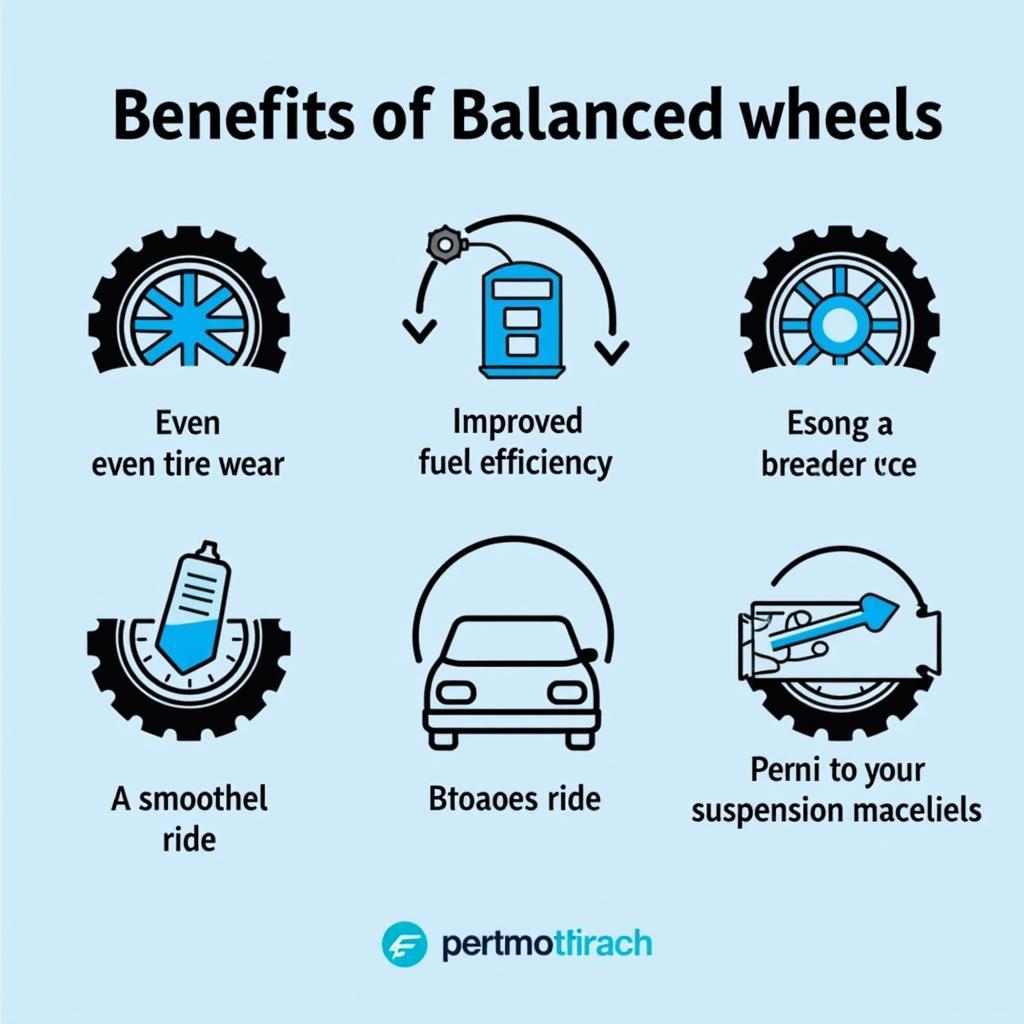Car Wheel Balancing Problems can manifest in various ways, from subtle vibrations to significant handling issues. Understanding the causes, symptoms, and solutions is crucial for maintaining a safe and comfortable driving experience. This guide provides a detailed overview of everything you need to know about car wheel balancing problems.
After a smooth ride, have you ever felt a slight shimmy in the steering wheel? This could be an early sign of wheel balancing issues. See our guide on car problems reviews for more information on common car issues.
What Causes Car Wheel Balancing Problems?
Several factors can contribute to wheel imbalance, including:
- Uneven tire wear: Tires wear down over time, and this wear isn’t always uniform. Uneven wear can create imbalances that affect the wheel’s rotation.
- Loss of wheel weights: Small weights are attached to the wheel rim to balance the assembly. These weights can sometimes fall off, leading to imbalance.
- Damage to the wheel or tire: Impacts with potholes or curbs can damage the wheel or tire, creating imbalances.
- Improper tire mounting: If a tire isn’t mounted correctly, it can lead to uneven weight distribution.
 Common Causes of Wheel Imbalance
Common Causes of Wheel Imbalance
Recognizing the Symptoms of Unbalanced Wheels
Identifying wheel balancing problems is essential for timely intervention. Common symptoms include:
- Vibration in the steering wheel: This is often the first noticeable sign of imbalance, especially at higher speeds.
- Vibration in the floorboard or seats: As the imbalance worsens, vibrations can be felt throughout the vehicle.
- Uneven tire wear: Unbalanced wheels can cause tires to wear down prematurely and unevenly.
- Reduced fuel economy: Imbalance increases rolling resistance, leading to decreased fuel efficiency.
- Increased stress on suspension components: Unbalanced wheels put extra strain on the suspension system.
Knowing what can cause vibrations in your car can be helpful in diagnosing the problem. Check out our resource on what is the problem when car vibrates for a more comprehensive look.
How to Fix Car Wheel Balancing Problems
Balancing your car wheels is a relatively straightforward procedure typically performed by a tire shop. The process involves:
- Mounting the wheel on a balancing machine: The machine spins the wheel to determine the location and amount of imbalance.
- Attaching corrective weights: Small weights are attached to the wheel rim to counteract the imbalance.
- Rechecking the balance: The wheel is spun again to ensure it is properly balanced.
Preventing Car Wheel Balancing Problems
While some causes of imbalance are unavoidable, proactive measures can help minimize the risk:
- Regular tire rotations: Rotating your tires helps ensure even wear and tear.
- Proper tire inflation: Maintaining the correct tire pressure is crucial for even wear and optimal performance.
- Avoid potholes and other road hazards: Driving carefully can help prevent damage to your wheels and tires.
- Regular wheel alignments: Wheel alignment ensures your wheels are properly positioned, minimizing uneven wear.
For those interested in learning more about various car problems, our list of major car problems pdf provides a comprehensive overview.
When to Seek Professional Help
If you suspect your car has wheel balancing problems, it’s best to consult a qualified technician. They have the expertise and equipment to diagnose and address the issue effectively.
“Ignoring wheel balancing issues can lead to more serious problems down the road, such as premature tire wear and suspension damage,” says John Smith, a certified automotive technician with over 20 years of experience.
 Benefits of Balanced Wheels
Benefits of Balanced Wheels
Conclusion
Car wheel balancing problems are a common issue that can significantly impact your driving experience. Recognizing the symptoms and addressing the problem promptly are essential for maintaining a safe, comfortable, and efficient ride. Don’t hesitate to contact us at AutoTipPro for further assistance or to schedule an appointment. Our phone number is +1 (641) 206-8880, and our office is located at 500 N St Mary’s St, San Antonio, TX 78205, United States.
If you’re experiencing a problem with a tire, you might want to consult our resource on problem with a tite on a car.
FAQ
- How often should I have my wheels balanced? It’s generally recommended to have your wheels balanced every other tire rotation or every 6,000-8,000 miles.
- Can I balance my wheels myself? While possible with specialized equipment, it’s best to have it done by a professional.
- How much does wheel balancing cost? The cost varies depending on the location and service provider, but it’s typically a relatively affordable service.
- What happens if I don’t balance my wheels? Ignoring wheel balancing problems can lead to premature tire wear, suspension damage, and reduced fuel economy.
- Can unbalanced wheels cause a car to pull to one side? While not a direct cause, unbalanced wheels can exacerbate existing alignment issues, potentially contributing to pulling.
- Can unbalanced wheels damage my rims? Unbalanced wheels can put extra stress on the rims and potentially lead to damage over time.
- How long does wheel balancing take? The process usually takes about 15-30 minutes.
“Balancing your wheels is a small investment that can save you money and hassle in the long run,” advises Maria Garcia, a senior tire technician with over 15 years of experience. Remember, regular maintenance is key to a safe and enjoyable driving experience. Don’t hesitate to reach out if you have any questions or concerns regarding car wheel balancing problems. If you’re looking into vibration issues related to added mass, explore this article: frequency of vibration added mass to car physics problem.






Leave a Reply